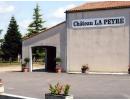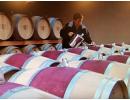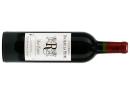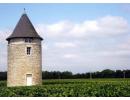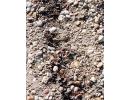Chateau La Peyre
Château La Peyre Cru Artisan – Saint Estéphe
The wine is a blend of 50% Cabernet Sauvignon and 50% Merlot, the vines average age is 30 years old representing 6.80 ha producing a yield of 47 hl/ha on average. Once the grapes have been hand harvest and sorted at the cellar they are destemmed. The grains will undergo a pre-fermentation skin maceration at a cold temperature for a couple of days to extract colour, flavours and structure. The fermentations last 3 to 4 weeks in stainless steel vats at 23-28°C. The wine is aged in french oak barrels for 12 to 15 months of which 30% to 40% are new depending on the vintage.
PVins notes: Dark red in colour, expressive aromas with subtle hints of oak in its youth. On the palate the oak is well integrated, the firm tannins of a Saint Estéphe are tamed by the Merlot providing an elegant tannic structure and balance. The wine may be cellared for 15+ years depending on the vintage.
Château La Peyre is located at Leyssac in the commune of Saint Estéphe. It is the only “Cru Artisan” estate in the appellation Saint Estéphe since the 2006 official classification which is done every ten years. René joined the organisation in 1992, the term “Cru Artisan” has been used for more than 150 years in the Médoc region. Only 40 estates are classified, some of the regulations to be classified are: the estate must be family owned, the wine must be estate bottled and wines produced must be tasted and approved by a panel every year.
René RABILLER took over the estate in 1986 from his father Raymond. His father Raymond, a baker, purchased 1 hectare of vineyard in 1946-47, but after deciding to become a full time vigneron he acquired a further 5 ha in 1973. In 1986, René decided to return to the estate when his father retired. Up until 1989, all the grapes were sold to the Saint Estéphe Coopérative, but René decided to make and estate bottle his own wines and therefore created Château La Peyre. In 1993, his wife Dany joined him to manage the Château.
The 8 ha of Château La Peyre are split up into two appellations, 1.20 ha as Haut Médoc in the commune of Cissac and 6.80 ha in Saint Estéphe. Regarding the vineyard in Saint Estéphe it is planted on 2 different types of terroirs. Near the Gironde estuary 50% of the estate is planted on gravelly soil located in the Marbuzet area, which is planted with Cabernet Sauvignon. The other 50% planted with Merlot is located at the Butte de Coutelin area where the soil is sandy with clayey-limestone. The vine plantation is high in density at 8,000 vines per hectare. The vines average an age of 35 years old, but some are over 50 years old having survived the devastating frost of 1956. The work in the vineyard involves canopy management and green harvest when necessary, the harvest is hand-picked.
The winemaking process is classic for Bordeaux. The Cabernet Sauvignon and Merlot are hand-picked at full maturity producing an average yield of 47 hl/ha. On arrival at the cellar the grapes will be sorted and transfered to a vibrating table to remove water if any and remove unwanted small particles. Before the fermentation the grapes will be destemmed and a skin maceration at a cold temperature will be carried out for a few days, this is to extract colour, fruitiness and improve the overall structure. The Fermentations will be done in stainless steel vats and last about 4 weeks at 23°C to 28°C. The wine is then aged in French oak barrels for 12 to 15 months with 30% to 40% of new oak depending on the vintage. The fining is made using egg whites and the wine is bottled at the Château. Production is about 50,000 bottles.
links: AOP Saint Estéphe - Médoc map - Bordeaux map
SAINT ESTEPHE
The appellation Saint Estéphe was created in 1936. It is one of the 6 communal appellations of the Médoc sub-region located whithin the Haut Médoc area north-west of Bordeaux. It is the second biggest communal appellation covering 1,250 hectares. The appellation has 5 Grand Cru Classé (Growth wines) following the 1855 classification, which include two famous 2nd growth estates Château Montrose and Château Cos d’Estournel.
Saint Estéphe - 1855 Grand Cru Classé:
2nd Growth: Château Cos d'Estournel, Château Montrose
3rd Growth: Château Calon-Ségur
4th Growth: Château Lafon-Rochet
5th Growth: Château Cos Labory
History
Viticulture is believed to have started with the Romans and during the Middle Ages the wine business expanded, thanks to English buyers who regularly came to the port of Bordeaux for their wine. The draining of marshland, which began in the 17th century initiated by the Dutch, made larger areas of land available for cultivation.
Vineyard
Located between Pauillac to the south and Médoc to the north, the soil is mainly made up of limestone and gravel deposits with some clay and sand further inland from the Gironde estuary. The eastern area of the appellation has more gravel in its soil composition where you will find Château Montrose, Château Cos d’Estournel and Château Calon Ségur. The vineyards are on gentle slopes at 10m to 23m above sea level.
The grape varieties planted are Cabernet Franc, Cabernet Sauvignon, Merlot, Carménère, Malbec and Petit Verdot. The blend is usually Cabernet Sauvignon dominant followed by Merlot. There are no white wines produced under the appellation Saint Estéphe. The wines are known for their tannic structure in their youth compared to the other communal appellations of Margaux, Pauillac and Saint Julien, they are also dark in colour with a good acidity. They have a great ageing potential especially in excellent vintages
Climate
Bordeaux's climate is oceanic however, the summers tend to be warmer and the winters milder than most areas of similar classification. Summers are warm and long due to the influence from the Bay of Biscay, but sometimes there may be substantial rainfalls. Winters are cool because of the westerly winds from the Atlantic. Also frosts in the winter are frequent, occurring several times during a winter, but snowfall is very rare. The estuary of the Gironde also provides a micro-climate.



